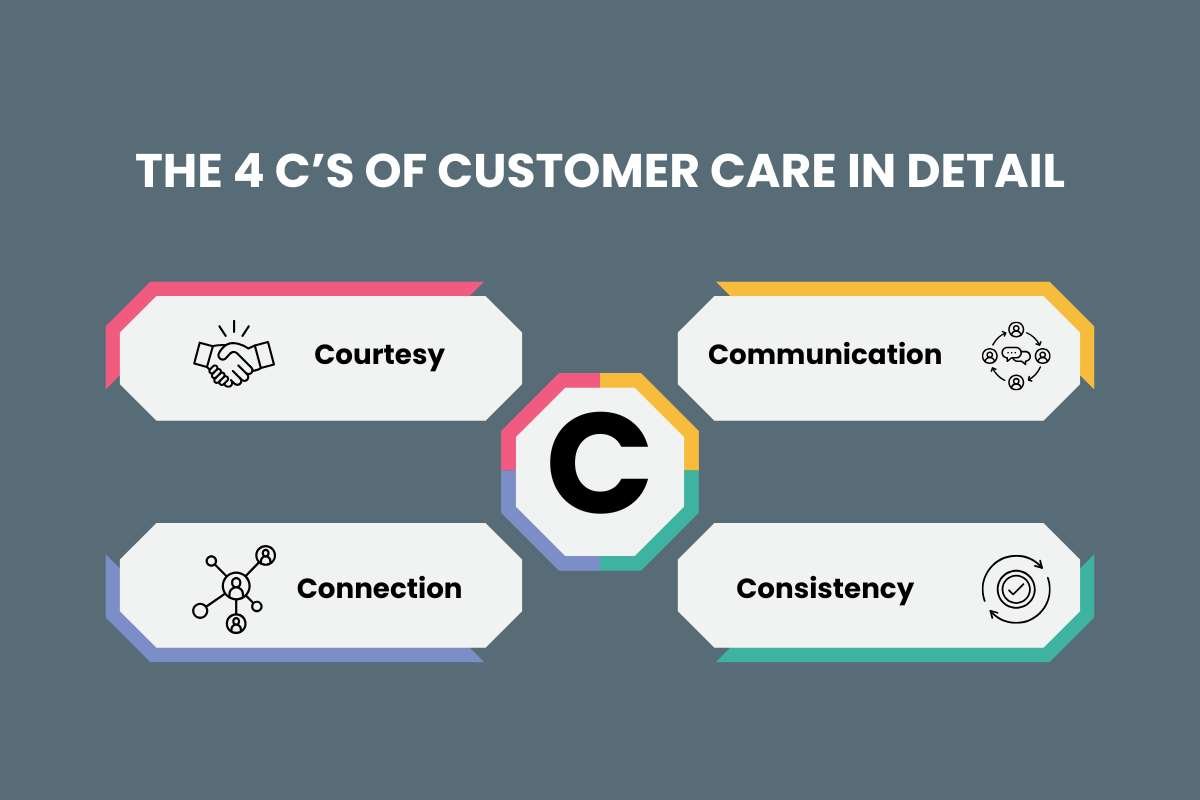You walk into your favorite cafe, and before you even speak, the barista knows your order and adds a smile with it. That’s not just service, it’s care. Businesses that nail customer care don’t just sell products; they sell happiness, trust, and a reason to return.
Today, treating customers right is no longer optional; it’s a survival. Stick with me, and by the end of this article, you’ll see why customer care is the secret ingredient to lasting success.
What is Customer Care? Core Concepts and Evolution
What is customer care? It is the practice of enhancing the entire customer relationship through personalized attention, empathy, and solutions that meet both emotional and practical needs. Unlike traditional customer service, which often reacts to problems, customer care anticipates them and creates preventive measures.
Historically, businesses treated customer issues as minor support functions. In the 20th century, “customer service” became a separate department. Today, “customer care” reflects a shift toward a company-wide mindset. Leaders now know that customer experiences define brand loyalty more than price.
Evolution Timeline
- 1950s: Businesses started call centers and hotlines.
- 1990s: Email transformed communication speed.
- 2010s: Social media made customer voices louder.
- 2020s: Technology embedded AI-based personalization in what is customer care?.
This shift means customer care is not static; it grows with customer expectations.
Why Customer Care Matters for Business Growth?
What and why does it matter? Because without it, no marketing or product strategy can hold customers. Studies show that poor experiences drive 32% of customers to stop doing business after only one bad interaction. On the other hand, brands known for care retain trust for years.
Statistics:
- Companies with strong customer care outperform competitors by 80% in satisfaction metrics.
- 73% of customers say good experiences are key to brand loyalty.
Customer care is also directly tied to revenue. For example, American Express reported that customers are willing to spend 17% more on brands offering excellent experiences. This proves that asking what customer care is translates directly to asking how we keep revenue flowing steadily.
Read More:
How to Discover What Your Customers Really Want?
The 4 C’s of Customer Care in Detail

The four C’s form the foundation of what customer care is. They shape how businesses interact with customers, not just in single transactions but throughout the entire customer journey. By focusing on Courtesy, Connection, Communication, and Consistency, companies can develop deeper trust, foster loyalty, and create positive experiences that last long after a purchase.
1. Courtesy:
Courtesy is the art of respecting and valuing every customer. It’s the first impression and the lasting memory of any interaction. Courtesy goes beyond politeness; it reflects empathy and understanding.
- Meaning: Treating customers with dignity, patience, and kindness in every situation, even during conflicts.
- Why it’s important: Customers who feel respected are more likely to forgive mistakes and remain loyal.
- Example: An airline employee patiently helping a stressed parent traveling with kids not only solves logistical issues but also builds goodwill.
Courtesy reminds us that care for customers is a human-first principle that sees customers as people, not numbers.
2. Connection:
Connection is about building meaningful relationships. It shifts focus from “one-time purchases” to long-term partnerships. Customers who feel emotionally connected to a brand are far more likely to return and recommend it.
- Meaning: Creating trust and emotional bonds with customers by personalizing experiences and remembering preferences.
- Why it’s important: Studies show that fully connected customers are 52% more valuable than highly satisfied customers.
- Example: A coffee shop waitress remembering your name and your usual order makes you feel valued, strengthening the connection.
This proves that it is an ongoing dialogue built on trust.
3. Communication:
Communication is the bridge between care and clarity. Poor communication can undo even good intentions, while effective communication strengthens customer confidence.
- Meaning: Providing clear, timely, and transparent updates, whether about delivery times, solutions, or problems.
- Why it’s important: 96% of customers say transparency influences their loyalty to a brand.
- Example: An e-commerce brand proactively emailing updates about delayed shipping shows respect for customers’ time and keeps trust alive.
In simple terms, what customer care is becomes most visible in how well you communicate, listen actively, and speak clearly.
4. Consistency:
Consistency is the final pillar. A single great interaction won’t build loyalty if the next one disappoints. Customers expect the same high-quality care every time they interact with a brand.
- Meaning: Delivering reliable, predictable service across all touchpoints, from in-store to online chats.
- Why it’s important: 87% of customers say consistent experiences across platforms impact loyalty.
- Example: A global hotel chain offering the same level of warmth, cleanliness, and support whether in Tokyo or New York.
When businesses deliver consistency, what care of customer changes from an occasional act into a company-wide standard.
Why the 4 C’s Matter?
When an organization commits to Courtesy, Connection, Communication, and Consistency, this shifts from reactive to strategic. Customers don’t just get answers; they get experiences that make them feel valued. This is how businesses build repeat loyalty and brand advocacy.
In short, the 4 C’s transform the idea of what customer care is. From a problem-solving role to a long-term trust-building system.
Differences Between Customer Care, Customer Service, and Customer Support
People often confuse these terms, but they are different layers of the same customer-focused strategy.
| Aspect | Customer Service | Customer Support | Customer Care |
| Focus | Solves questions and issues. | Fixes technical/product problems. | Builds trust and relationships. |
| Goal | Quick resolutions. | Ensure the product works well. | Create loyalty through empathy. |
| Approach | Reactive. | Reactive and technical. | Proactive and personal. |
| Example | Tracking an order. | Repairing software. | Sending thanks or a personalized follow-up. |
| Timeframe | Short-term fixes. | Short-term technical help. | Long-term relationship focus. |
Key takeaway: Customer service and support solve problems, while what is customer care adds emotional connection and long-term loyalty.
Technology and Tools Shaping Modern Customer Care

What is customer care in the digital age? It’s powered by tools like:
- AI chatbots for instant help.
- CRM systems to track customer journeys.
- Social listening tools to catch feedback in real time.
- Data analytics to predict customer needs.
According to Salesforce, 80% of customers say experience is as important as products. Technology makes care faster, but human touch still wins hearts.
Building a Customer-First Culture Within Organizations

What is customer care inside an organization? It’s not just a department, it’s a mindset. A customer-first culture means putting the customer at the center of every decision, from how products are made to how support teams respond.
Zappos is a great example. Their staff are free to go beyond scripts and spend as much time as needed with a customer, showing that care matters more than speed.
Leadership plays a key role, too. When managers model empathy and recognize employees who go the extra mile, it sets the tone for the whole company. Success should also be measured by satisfaction and loyalty, not just sales.
In short, a customer-first culture turns care into a daily habit that strengthens both trust and business growth.
Turning Challenges into Opportunities: Case Studies
What is customer care when things don’t go as planned? The real test of care is not when everything runs smoothly but when problems appear. How a company responds in tough moments can turn a disappointed customer into a lifelong fan. Let’s look at real case studies that show this in action.
- Amazon – Many customers worry about online returns, but Amazon solved that pain point with its no-questions-asked return policy. Instead of making customers fill endless forms or wait weeks, Amazon makes returns fast and hassle-free. This simple act transforms frustration into relief and builds trust, which is why millions of people shop there again and again.
- Starbucks – The coffee giant understands that loyalty comes from personal connection. Through its mobile app, Starbucks offers personalized drink suggestions, rewards, and even remembers your favorite order. When a customer feels seen and valued, even small problems, like a wrong order, don’t push them away. Instead, the app encourages repeat visits and strengthens the bond.

- Apple – Technology can be frustrating, but Apple’s Genius Bars show how care can change the game. Instead of making customers struggle with technical manuals, Apple provides in-store experts who solve issues face-to-face. The mix of technical expertise and genuine empathy creates memorable experiences. Many customers walk away not only with a fixed device but with a stronger love for the brand.
These examples show that, when businesses handle problems with empathy and smart solutions, customers don’t just forgive mistakes; they respect the brand more and often share their positive stories with others.
Measuring Success and Preparing for the Future of Customer Care
To measure what is customer care, companies must track tangible metrics.
- Net Promoter Score (NPS): Measures loyalty based on recommendations.
- Customer Satisfaction Score (CSAT): Reflects direct happiness with an interaction.
- Customer Retention Rate: Shows how long customers stay with the brand.
- Resolution Time: Tests efficiency without compromising empathy.
Looking ahead, businesses must invest in predictive analytics, sentiment recognition, and humanized automation.
Facts and Verified Stats with Sources
- 32% of customers stop doing business after a single poor experience.
- American Express found that people spend 17% more with businesses offering exceptional care.
- Companies with engaged employees see a 233% increase in customer loyalty.
- 73% of people prioritize great experiences over price.
- By 2026, customer experience will dominate 81% of competitive strategies.
Conclusion
What is customer care after all this? It’s the coffee shop smile, the quick return policy, the chatbot that answers at midnight, and the human who listens when you’re upset. Businesses that ignore it lose customers; those who master it win loyalty. Like the cafe barista who knows your order, is about creating moments that matter. If you invest in it today, your brand won’t just grow; it will stay loved for years to come.









